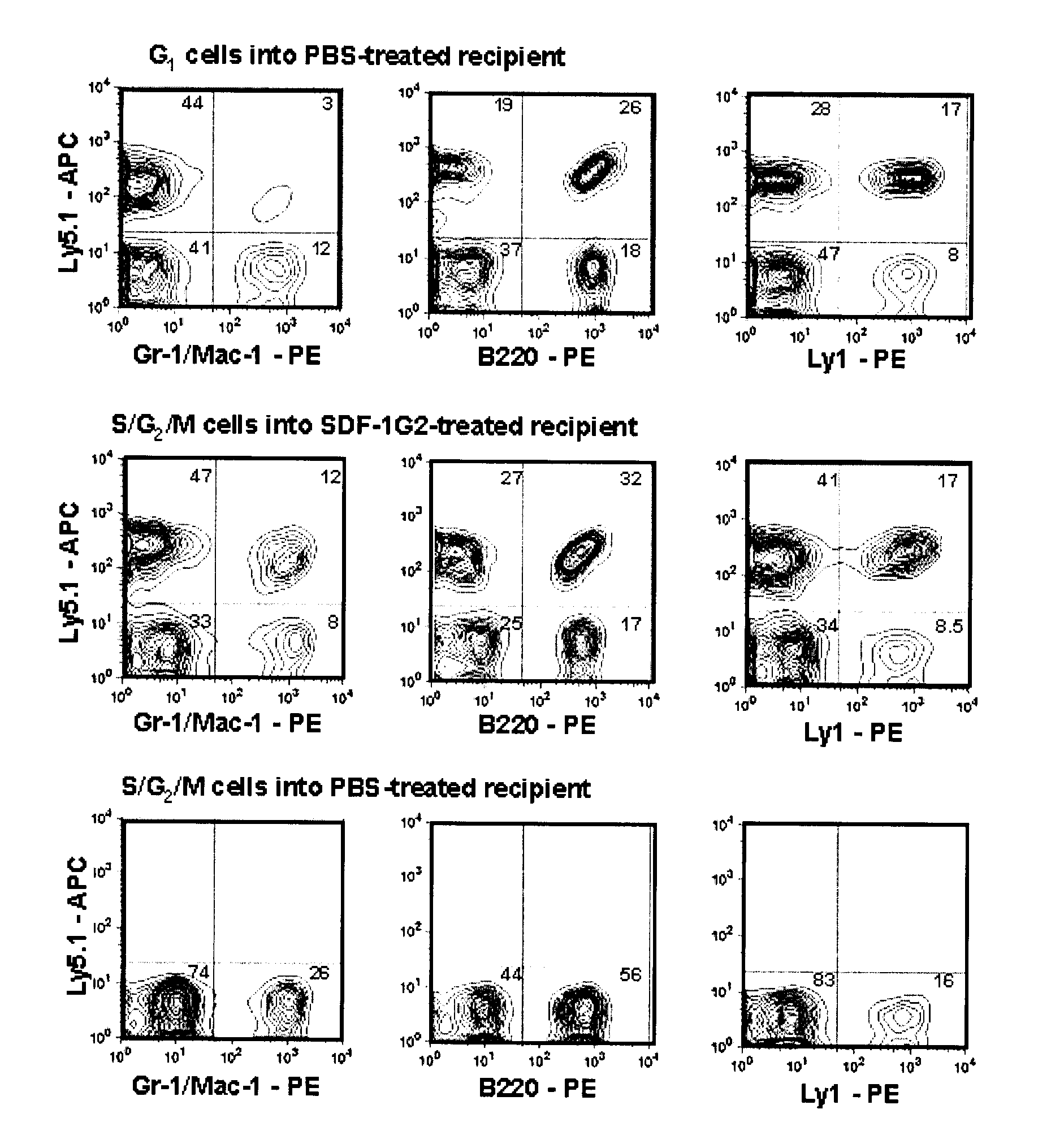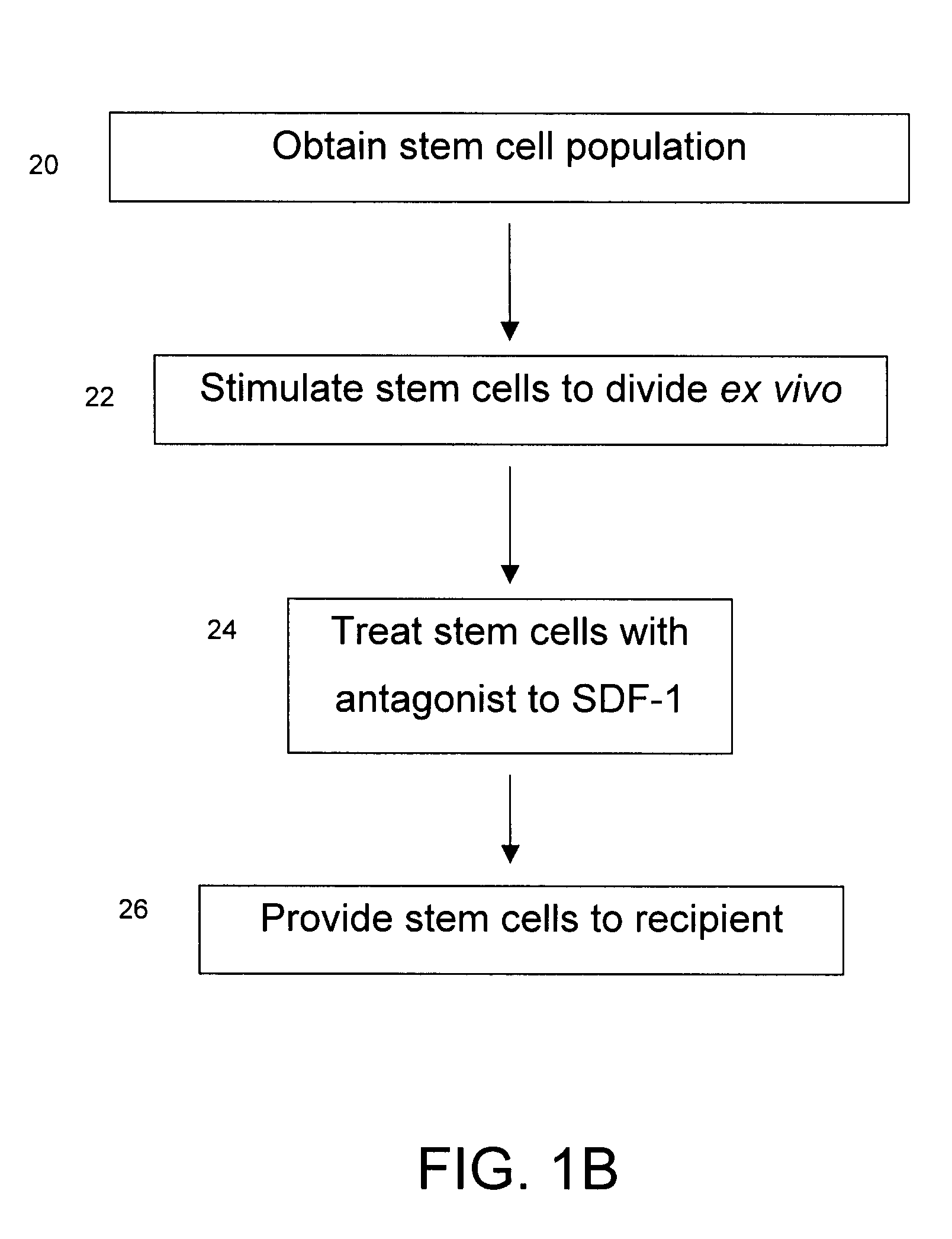Method and composition for increasing the engraftment efficiency of stem cells
a technology of stem cells and engraftment efficiency, which is applied in the direction of animal/human proteins, biocide, plant growth regulators, etc., can solve the problems of limiting the number of hscs available, increasing the risk of medical complications, and grafting failur
- Summary
- Abstract
- Description
- Claims
- Application Information
AI Technical Summary
Benefits of technology
Problems solved by technology
Method used
Image
Examples
example 1
Enhancement of Engraftment Efficiency of Transplanted Stem Cells by Treatment of Recipient
[0068]An exemplary method is provided herein to enhance engraftment efficiency of stem cells transplanted into a recipient after the stem cells have been induced to proliferate or enter S / G2 / M phase ex vivo.
[0069]FIG. 1A illustrates the method employed. Stem cells are obtained by isolation of cells from the donor (10), for example by collection of mobilized peripheral blood or cord blood. Following isolation, the stem cells are cultured in the presence of suitable media and growth factors to stimulate the population of stem cells to divide ex vivo (12). Prior to delivery of the stimulated stem cells, the recipient is treated (14) with a SDF-1 antagonist using a treatment dosing schedule in an amount adequate to enhance engraftment of the stem cells. The stem cells are then provided to the recipient (16) by infusion or injection. Typically, the recipient is a subject that has been treated to pur...
example 2
Enhancement of Engraftment Efficiency of Transplanted Stem Cells by Treatment of Stem Cells Ex Vivo
[0071]An exemplary method is provided herein to enhance engraftment efficiency of stem cells transplanted into a recipient after the stem cells have been induced to proliferate or enter S / G2 / M phase ex vivo.
[0072]FIG. 1B illustrates the method employed. A population of stem cells is obtained (20) for example by isolating cells derived from a donor. This may be done by collection of mobilized peripheral blood or cord blood. The stem cells obtained are cultured in the presence of suitable media and growth factors to stimulate the population of stem cells to divide ex vivo (22). The stimulated stem cells are treated (24) with a SDF-1 antagonist at a concentration adequate to enhance engraftment of the stem cells. The stem cells are then provided to the recipient by infusion or injection (26). Typically, the recipient is a subject that has been treated to purge their bone marrow of preexis...
example 3
Hematopoietic Stem Cells Proliferate Until After Birth and Show a Reversible Phase-Specific Engraftment Defect
[0074]In order to illustrate the effect of SDF-1 antagonists on improving engraftment, experiments are described herein which assess HSC proliferative status in mice at different stages of development. This experiment shows that the entire HSC population remains in cycle until the 3rd week after birth regardless of the tissue in which the HSCs are located. Then within one week, the majority of the HSCs switch abruptly from an actively dividing to a quiescent state. Until this switch occurs, those HSCs that are in S / G2 / M show the same engrafting defect previously demonstrated for adult HSCs that have been stimulated to divide. Interestingly, prior to the establishment of a quiescent HSC population, the HSCs in S / G2 / M were found to express higher levels of SDF-1 than those in G1 and their defective engrafting activity could be completely reversed, either by holding them ex viv...
PUM
| Property | Measurement | Unit |
|---|---|---|
| volume | aaaaa | aaaaa |
| concentration | aaaaa | aaaaa |
| concentration | aaaaa | aaaaa |
Abstract
Description
Claims
Application Information
 Login to View More
Login to View More - R&D
- Intellectual Property
- Life Sciences
- Materials
- Tech Scout
- Unparalleled Data Quality
- Higher Quality Content
- 60% Fewer Hallucinations
Browse by: Latest US Patents, China's latest patents, Technical Efficacy Thesaurus, Application Domain, Technology Topic, Popular Technical Reports.
© 2025 PatSnap. All rights reserved.Legal|Privacy policy|Modern Slavery Act Transparency Statement|Sitemap|About US| Contact US: help@patsnap.com



